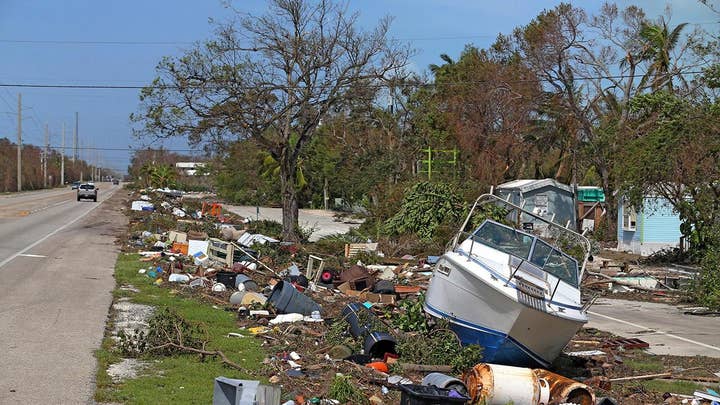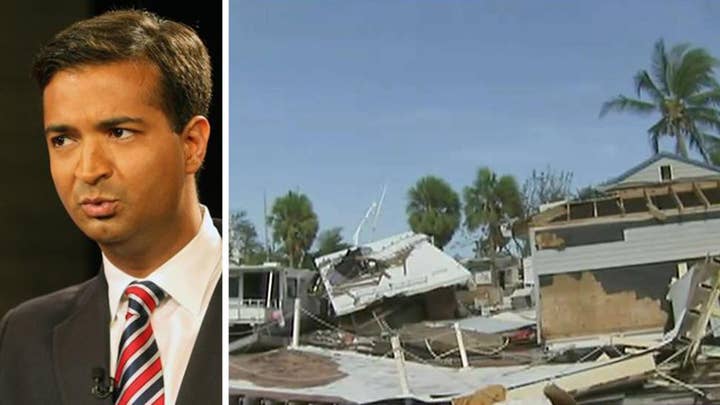Drone footage reveals staggering damage in Florida Keys
Hurricane Irma's storm lifted some homes off their foundations, turned others to debris; Phil Keating reports from Islamorada, Florida
Two days after Hurricane Irma roared into the Florida Keys with 130 mph winds, residents are being allowed slowly to return to the parts of the island chain closest to Florida’s mainland. However, preliminary estimates suggested that 25 percent of the homes in the Keys were destroyed and 65 percent sustained major damage, federal officials said.
“Basically every house in the Keys was impacted,” Federal Emergency Management Agency administrator Brock Long said.
While nearly all of Florida was engulfed by the 400-mile-wide storm, the Keys — home to about 70,000 people — appeared to be the hardest hit. Drinking water and power were cut off, all three of the islands’ hospitals were closed, and the supply of gasoline was extremely limited.
Officials said it was not known how many people ignored evacuation orders to stay behind in the Keys.
While the Keys are studded with mansions and beachfront resorts, about 13 percent of the people live in poverty and could face big obstacles as the cleanup begins.
“People who bag your groceries when you’re on vacation, the bus drivers, hotel cleaners, cooks and dishwashers, they’re already living beyond paycheck to paycheck,” said Stephanie Kaple, who runs an organization that helps the homeless in the Keys.
An aircraft carrier was positioned off Key West to help in the search-and-rescue effort. And crews worked to repair two washed-out, 300-foot sections of U.S. 1, the only highway from the mainland, and check the safety of the 42 bridges linking the islands.
Authorities stopped people and checked for documentation such as proof of residency or business ownership before allowing them back into the Upper Keys, including Key Largo, Tavernier and Islamorada.
The Lower Keys — including the chain’s most distant and most populous island, Key West, with 27,000 people — were still off-limits, with a roadblock in place where the highway was washed out.
The full extent of the death and destruction remained a question mark because cellphone service was disrupted and some places were inaccessible.
The number of people without electricity in the steamy late-summer heat dropped to around 10 million — half of Florida’s population. Utility officials warned it could take 10 days or more for power to be fully restored. About 110,000 people remained in shelters across Florida.
The number of deaths blamed on Irma in Florida climbed to 13, in addition to four in South Carolina and two in Georgia. At least 37 people were killed in the Caribbean.
“We’ve got a lot of work to do, but everybody’s going to come together,” Florida Gov. Rick Scott said. “We’re going to get this state rebuilt.”
In Key Largo, Lisa Storey and her husband said they had yet to be contacted by the power company or by city, county or state officials.
“That’s a beautiful sound, a rescue sound,” she said, as a helicopter passed overhead.
In Lower Matecumbe Key, just south of Islamorada, 57-year-old Donald Garner checked on his houseboat, which had only minor damage. Nearby, three other houseboats were partially sunk.
Garner had tied his to mangroves.
“That’s the only way to make it,” said Garner, who works for a shrimp company.
Corey Smith, a UPS driver who rode out the hurricane in Key Largo, said it was a relief that many buildings on the island escaped major damage. But he said conditions were still not good, with branches blocking roads and supermarkets closed.
“They’re shoving people back to a place with no resources,” he said by telephone. “It’s just going to get crazy pretty quick.”
The Associated Press contributed to this report.




